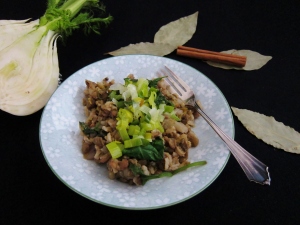
Yes, you read correctly: muffins with lentils! But before I reveal more about this amazing idea for sneaking healthy proteins into your next sweet snack:
Welcome to the New Year! Wishing you all that is good and beautiful for 2015….. which very neatly brings me back to lentils: eating lentils at the beginning of the new year is an Italian custom that associates lentils with prosperity. And although I am in no way Italian, I enjoy symbolic traditions (and lentils). I was searching for a creative new way to prepare them when I stumbled across this recipe, which of course I could not resist. I will admit I was a little doubtful, but (trust me on this) it works!
These muffins are moist, not too sweet, full of flavour (and none of it ‘lentily’) and last but not least they are actually rather healthy: I made them using half whole wheat flour (I have not tried but am sure you can experiment increasing the whole wheat ratio). Also they are made with oil instead of butter. Granted, they contain sugar, but really…… who is going to be thinking about that when they are biting into a muffin that is studded with power packed lentils 😉
I split the batter in to batches to experiment with frozen cherries, blueberries and raspberries. It was a close call, but I slightly preferred the raspberries because of beautiful contrast between the tart fruit and the rich chocolate. Nonetheless I think I will take the same approach next time and making different batches as I liked the variation. I am sure there are many more options for filling them: chocolate chips and walnuts, half a plum, a strawberry, poached pear…..By the way, I did make some without any fruit, but I found them a little dry and plain in comparison.
But whatever you add, do not leave out the lentils 🙂
Ingredients
(a hardly altered from the blog “Our Fresh Kitchen“)
12 muffins
75g (3/4 cup) green lentils
About 225ml (1 3/4 cup) water
1/2 tsp salt
60g (1/4 cup) all purpose flour
65g (1/4 cup) whole wheat flour
50-60g (1/2 cup) Demerara sugar (NL: donkere basterd suiker DE: dunkeler brauner Zucker)
30g (1/4 cup) cocoa powder
1 generous tsp baking powder
1/2 tsp baking soda
1/4 tsp chilli flakes
125ml (1/2 cup) mild tasting olive oil
2 eggs (see “tips” for vegan alternative)
1 tsp vanilla essence
200g frozen fruit (either half blueberries half raspberries or all of one sort)
Recipe
- Bring lentils, water and salt to the boil. Simmer on a low heat for about 45 min. Check half way through to ensure there is enough water. Cook until lentils are very soft and all the water is absorbed.
- When the lentils are done remove from heat and allow to cool slightly about 10 min.
- Preheat oven to 190C (375F).
- Prepare your 12 hole muffin tin(s) (If using a silicon muffin tin no grease is needed otherwise you might want to grease your tin or line it with paper cups).
- In a large bowl combine the dry ingredients – the two types of flour, sugar, cocoa, baking powder and – soda as well as the chili flakes.
- In a second bowl or measuring cup combine oil, egg and vanilla. Whisk to combine.
- Stir the cooked lentils into the dry mix and combine. Then stir in the wet ingredients – the oil, egg and vanilla.
- Fold fruit into the batter (even if you are using both types of fruit you can easily use the one large bowl to fold blueberries under half the batter and raspberries under the other half)
- Spoon the batter into the prepared muffin tin.
- Bake for about 20-25 min or until a toothpick inserted in the center comes out clean (do not over bake as the muffins will dry out).
- Remove the muffins from the tin and allow to cool on a wire rack.
- Store in an airtight container in the fridge.
Tips & Variations
- For a vegan recipe replace the eggs with a mix of 2 tbsp chia seeds and 6 tbsp water that you allow to sit for 5 min until it forms a gel
- Instead of the berries you can fold in chocolate chips and/or walnuts, half a plum, a strawberry, poached pear
I have linked this post to the novice gardener’s fabulous initiative of hosting fiesta Fridays
https://thenovicegardener.wordpress.com/2015/01/09/fiesta-friday-50/





















